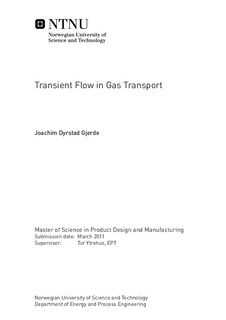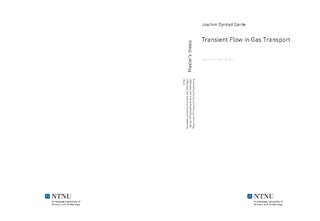| dc.description.abstract | Transport of natural gas to continental Europe and UK is a large portion ofNorwegian petroleum industry. The gas is mainly transported undersea inlarge-scale transport pipelines. Amount of transported gas is currently closeto maximum capacity of the pipeline network, and as a consequence the gastransport must be careful planned so that the optimal capacity can be utilized.An important tool in this planning is the use of computational method topredict the flow. Accurate computational tools is therefore of great value whenpredicting the pressures and flow rates in transient cases such as opening of avalve or shut down of a flow. This report is a part of a major research projectinitiated by Gassco, for better flow-predictions models in natural gas pipelines.A computational model based on the method of characteristics has beendeveloped. In this report the main focus is on the solution of the energy equationand introduction of this equation to an already existing code solving for pressureand mass flux. The method is verified using measured values of pressure at theinlet.Since much of the uncertainty is related to the transients, this report focuseson transient cases. The old program solving the characteristic equations using anisothermal assumption actually proves surprisingly accurate, and the additionalsolution of temperature does not significantly improve the results. The methodhowever does not provide satisfactory results at the larger transients.If large temperature gradients are imposed on the solver we see instabilities inthe flow and it affects the solution of the parameters. The Joule Thomson effectthat we have in our solution also results in a much higher drop of temperaturethan what can be measured, in case of pressure drop at the inlet.From the results we also see that the coefficient that is supposed to correctfriction factor for additional drag effects, also should be a function of pressureand/or Reynold number. If such a correlation would provide more accurateresults in the transient has not been debated, but more accurate correlation offriction depending on flow rate would probably give a more accurate result.Also worth noticing is that the method does not have a clear convergence,or reduction of error as the number of calculation points increases. It givessmaller extreme values, but average error is not reduced significantly. This isprobably a result of the reduced effect of missing convective-term as the gridhas a finer resolution and time-step decreases and the effect of loss of velocityin the characteristic becomes small.As a simple tool for calculation of gas transport in pipelines, the isothermalmethod of characteristics proves to give surprisingly accurate results. However,for more complex systems, i.e. including the temperature and variable propertiessuch as compressibility and density, finite difference methods are more versatile.Finite difference methods can be done implicit, giving a more stable solver, andit s simpler to account for some of the effects such as temperature etc.iv | nb_NO |

